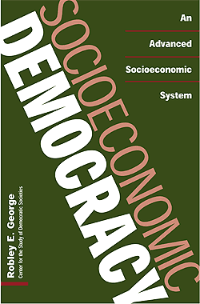Socioeconomic Democracy. An advanced socioeconomic system
Robley E. George, Praeger/Greenwood, USA, 2002

OCIOECONOMIC DEMOCRACY: An Advanced Socioeconomic System first defines and describes what is meant by the term Socioeconomic Democracy.
Socioeconomic Democracy is a model economic system, or more precisely, socioeconomic subsystem, in which there is some form of Universal Guaranteed Personal Income as well as some form of Maximum Allowable Personal Wealth, with both the lower bound on personal material poverty and the upper bound on personal material wealth set and adjusted democratically by all society.
The book then indivdually examines in some detail each of these two bounds, i.e., UGI and MAW. Next is democracy. Here we first consider a few preliminaries, including a discussion of the inevitability of democracy, a prehistory of majority rule and a brief discussion of contemporary qualitative democracy. We then consider the simple, mathematically correct procedure by which society, exercising quantitative democracy (employing the most elemental of public choice theory results), can democratically decide the amount or magnitude of these two bounds – and other amounts in question.
The book illustrates and looks at the many possible theoretical variations of Socioeconomic Democracy. Anthropological, philosophical, psychological, religious and human rights justifications for some form of Socioeconomic Democracy are next provided. The similarities, differences and relationships between Socioeconomic Democracy and Islami economics – in particular, Zakat, one of the five pillars of Islam – are examined. The book then considers economic incentive and self-interest in general and as associated with Socioeconomic Democracy. Next, the book examines a number of practical political approximations to, and some of the many financial benefits and reduced costs of, such a system. It then establishes the feasibility of and discusses the necessary implementation procedure to realize Socioeconomic Democracy. Finally, the book describes a number of the simultaneously realized ramifications of this fundamentally just and democratic socioeconomic system. The book concludes with an appendix containing exercises for the interested reader.
